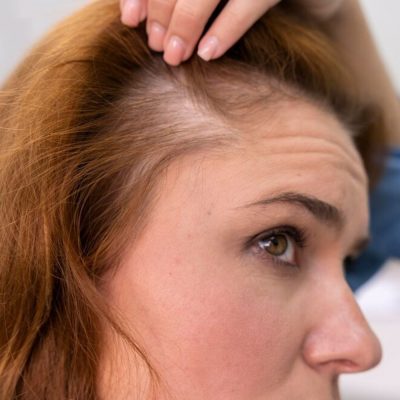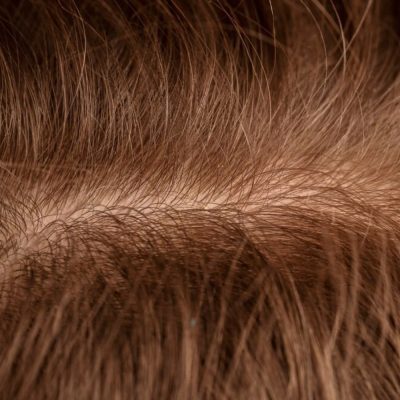Female Pattern Hair Loss
Female pattern hair loss is a very common condition affecting women, especially as they age. Unlike male pattern hair loss, it usually presents as diffuse thinning over the crown and top of the scalp, rather than complete baldness. At SkinAccess Clinics, we provide expert diagnosis and treatment options to help manage and treat female pattern hair loss effectively.

What is Female Pattern Hair Loss?
Female pattern hair loss is a type of androgenetic alopecia, influenced by genetic and hormonal factors. It is the most common type of hair loss affecting women, typically beginning in midlife, but can begin earlier. Unlike men, women usually experience a general thinning of the hair rather than distinct bald patches.
Symptoms of Female Pattern Hair Loss
Symptoms of female pattern hair loss can vary from person to person, but some common symptoms include
Gradual Thinning
Hair thinning, particularly at the crown and the top of the head.
Widening Part
As the hair thins, the parting line may become wider. This is often the first sign noticed by women.
Reduction in Hair Volume
Overall hair volume may decrease, making it appear less dense.
Diffuse Thinning
Women usually experience diffuse thinning over the entire scalp rather than developing distinct bald spots.
Causes of Female Pattern Hair Loss
Causes of female pattern hair loss are multifactorial. They include
Genetics play a significant role in female pattern hair loss. Women with a family history of hair loss are more likely to experience it themselves.
Hormonal fluctuations, especially related to pregnancy, menopause or polycystic ovary syndrome (PCOS / PCOD), can trigger or exacerbate hair loss.
During ageing, hair naturally tends to thin out due to the reduction of hair follicle size and density.
Conditions like iron deficiency, thyroid disorders or autoimmune diseases can lead to hair loss.

Diagnosis of Female Pattern Hair Loss
A comprehensive evaluation by a dermatologist is required to properly diagnose female pattern hair loss. This may involve
Medical History
A detailed medical and family history helps to understand any underlying factors that could contribute to hair loss.
Physical Examination
The scalp is examined to assess the pattern and extent of hair thinning.
Pull Test
A gentle pull test may be performed to evaluate the severity of shedding.
Blood Tests
Pathological investigations help to ascertain hormonal imbalances, thyroid issues or nutrient deficiencies.
Scalp Biopsy
At times, a scalp biopsy may be required to rule out other potential causes or to confirm the diagnosis.
Management and Treatment of Female Pattern Hair Loss
While there is no cure for female pattern hair loss, there are several treatment options to help manage the condition and promote hair growth. SkinAccess Clinics offers personalized treatment plans tailored to suit your specific needs
➥ Topical Treatments: Minoxidil when applied directly to the scalp, helps stimulate hair growth and slow down hair loss.
➥ Oral Medications: Some oral medications work by blocking the effects of androgens (male hormones) on hair follicles, reducing hair loss and promoting regrowth. Other medications, though rarely used, help to reduce DHT levels, which can contribute to hair thinning.
➥ Platelet-Rich Plasma (PRP) Therapy: PRP involves injecting platelet-rich plasma (derived from the patient’s blood) into the scalp. The growth factors in PRP help stimulate hair follicles and encourage hair regrowth.
➥ PDO Threads: PDO threads can activate and stimulate the cells within the hair follicles. They encourage cell division and proliferation, promoting the growth of new hair strands. This activation of dormant follicles and the stimulation of cellular activity contribute to the overall restoration of hair. It is most effective for early to moderate stages of hair loss.
➥ Hair Transplant Surgery: In severe cases, hair transplant surgery may be a viable option. The procedure involves transplanting individual hair follicles from areas of the scalp where hair is still thick to the thinning areas.
➥ Lifestyle & Hair Care Modifications:
- Healthy Diet: A balanced diet rich in essential vitamins and minerals is important for maintaining healthy hair.
- Gentle Hair Care: Using mild shampoos, avoiding harsh hair treatments and minimizing heat styling can help protect hair and prevent further damage.
Conclusion
Female pattern hair loss can be a very distressing condition for those suffering from it. However, with the right care and treatment plan, it is possible to manage and even promote hair regrowth. At SkinAccess Clinics, we offer an expert diagnosis with a range of treatment options tailored to best suit your condition. If you are experiencing hair loss, schedule a consultation with us today to explore your treatment options and take the first step toward healthier, fuller hair!
